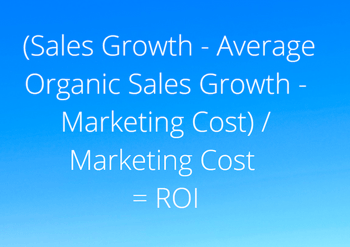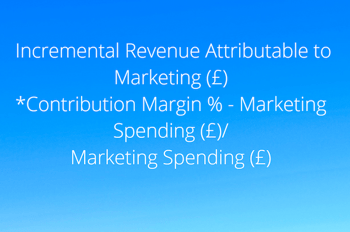The most straightforward way to grow revenue in any tech startup is to sell. However, no startup can sustain the costs of an enormous sales or marketing force. You can succeed and scale though through driving revenue and ROI to achieve scale. Read on to find out how digital marketing can help you get your market share.
To summarise, sales are the direct channel, the channel with a human face, driving 1:1 customer interaction.
Unfortunately, 100% pure direct selling doesn't scale well for everything and no startup can sustain an enormous sales force with their sales and marketing budget while also meeting customer expectations. Moreover, even if they could, it would come at the expense of the other areas of the business that need attention and investment - and that's simply not feasible.
Conversely, marketing is indirect, often automated, driving one to many customer interactions.
Less personalised than sales, the irony is that marketers often find themselves trying to recreate the characteristics of the direct sales channel through their brand, segmentation campaigns and positioning.
However, there is a simple truth and that is, without marketing, most products, services and solutions would never make it to market.
There is therefore, really only one reason to rely on marketing over sales: it’s cheaper – and that’s down to something called marketing leverage.

What is marketing leverage?
There are countless books, blogs, vlogs and guides on several websites and social media channels showing you how to drive revenue and revenue growth. But when you look closely, they're showing you how to drive revenue growth once – and just once.
Now that's great if you have a single product or solution, but startups very rarely have that luxury. You have to drive revenue growth across multiple streams and through multiple channels and tactics like search engine optimisation. Leverage marketing facilitates that process.
Similarly, those guides are helpful if you want a non-integrated / non-aligned marketing programme that simply strings together random campaigns in the vain hope that's going to do the job and achieve the result you are looking for or, alternatively, if you want to rush straight into execution without a thought as to how these campaigns reflect or integrate with your strategy. Either way, in order to make your current marketing efforts worthwhile, using the right leveraging strategy will not only improve customer loyalty but have a continuous positive ROI.
If you’re a startup serious about growth though, you’ll need a far more strategic approach that will increase your sales volume.
Marketing leverage is the method by which you create sustainable revenue growth through an increase in revenue and return on investment at the same time. By leveraging both your marketing activities and processes and through continual optimisation and improvement, you can drive both revenues and ROI to achieve scale, get your target market share and reach your target audience.
Startup Marketing Leverage
I'm sure we could discuss for hours whether marketing is an investment or a cost centre, but the reality is there is no such thing as a free lunch and you have to spend money on marketing in order to make money. Nothing is really free, a sales promotion has its hidden costs, SEO needs manpower, and so does every other thing in marketing.
As a startup, you want to drive revenues, so typically, you, your marketing team or your agency will create campaigns to do just that – campaign 1, 2, 3 – watch them fly. But is that enough?
The answer is no.
To create scalable, sustainable revenue growth, you need a strategic process that increases marketing leverage by driving that growth at the highest possible marketing ROI. This requires a balance of innovation and efficiencies. The goal is to drive more sales from both your loyal customers and potential customers.
The balance of Innovation and Efficiency
Innovation is a blend of new ideas, new creative, different channels, improved and relevant messaging, revised CTAs and data capture, or even an improved offer. Gaining an understanding of what really works for your audience. Continually improving and optimising.
Without an innovation process, the ROI of any existing campaigns will quickly level out and eventually peter out, which is to be avoided at all costs.
Efficiencies come from driving your ROI through cost per lead, cost per visitor, cost per transaction, increased open rates and click throughs etc.
Each innovative campaign or programme will drive a new revenue stream which can of itself, be optimised to drive increased revenues and ROI. By placing focus on both the revenue and the efficiencies - or costs – you are leveraging your startup marketing budget to the max.
How do you calculate the ROI of Startup Marketing
The most basic way to calculate the ROI of a startup marketing campaign is to integrate it into the overall business line calculation.
Take the sales growth from the business or product line, subtract the marketing costs, and then divide by the marketing cost.
(Sales Growth - Marketing Cost) /
Marketing Cost = ROI

However, this assumes that the total month-on-month sales growth is directly attributable to your marketing campaigns. Of course, as marketers we know it is…. but it helps to build relationships if we are realistic.
Therefore, we need to have a comparison - for example, the sales from the product line in the months prior to the campaign launching. Using a 6 or 12 month campaign lead up will help you to calculate the existing sales trend.
For example, if your sales team is seeing an organic growth rate of 5% per month over the last 12-month period, then your ROI calculation for your marketing campaign/s should strip out the 5% from the sales growth.
(Sales Growth - Average Organic Sales Growth - Marketing Cost) /
Marketing Cost = ROI

There are many ways to calculate ROI, but arguably one of the most effective ways is to calculate Return on Marketing Investment.
ROMI is different to a typical ROI calculation because marketing is not tied up in assets or inventory. Rather, marketing funds are typically ‘risked’ in that there is usually no tangible asset and often not even a predictable or quantifiable result to show for the spend.
However, as a startup marketer, you will want to show how the marketing strategy and activities contributed to the company’s financial health.
Therefore, ROMI is often defined as the contribution attributable to marketing (net of marketing spending)/ by the marketing invested or risked.
Incremental Revenue Attributable to Marketing (£) *Contribution Margin % - Marketing Spending (£)/
Marketing Spending (£)

Every campaign has its day
Of course, there will be a limit to the optimisation that can be achieved for each campaign. Even the golden goose has a shelf life. So, prior to reaching nirvana, you should be planning your next campaign, ready to launch as the previous one reaches its peak.
By implementing this cycle, you begin to generate not just scalable revenues, but revenues that can be ploughed back into your marketing (or sales) efforts. Without leverage, scale becomes a distant dream as you can only really maintain the status quo.
Startup Marketing Innovation. Place Your Bets
Despite what they may tell you, no agency has a crystal ball. It just doesn’t exist. But you do need a starting point.
With a myriad of choices and channels, the question is where do you start?
An experienced team or agency can start the innovation process by making educated assumptions on what works or has worked for similar customers, in similar markets. All ideas should be up for grabs, brainstormed and prioritised – and then put into action. Don’t dilly-dally. Don’t try and over optimise before you have even launched and don’t angst. Get your campaign in-market, then optimise and take the learnings.
Importantly though, make your innovation process part of your culture and your processes. Welcome ideas from everyone, not just the creatives. Creativity is a key part of innovation, but it’s not the sole reason for success.
Understanding your audience and their pain points will always trump pure creative without a strategy.
Failure is just a step in the startup marketing process
Whilst you definitely don’t want to take 10 years to become an overnight success, you have to be prepared for that fact that your first few campaigns will be a combination of test and learn and data collection. Any agency that tells you differently will not be doing their job properly. This is especially true if you haven’t run a campaign before.
By making educated guesses, your chances of success are higher, but even so, be prepared for results that may not be stellar. That’s why pilot campaigns with smaller, initial budgets are advisable.
Unless you can guarantee that red is absolutely going to come up, don’t blow all your budget on your first campaigns. Pilot - learn - iterate – execute.
If your campaign doesn’t produce the results you were expecting then stop, take the learnings and move on quickly. No blame, no backward glances, look to the future and go again.
Scaling Startup Marketing through Efficiencies
As a startup, marketing budget is limited. We all wish it were larger, but the harsh reality is marketing budgets are tight everywhere and we all need to make the most of them. The goal must be to leverage every single penny from each and every campaign and marketing activity.
But remember, given budgetary (and other) constraints, no company, whether in startup phase or not, can focus purely on revenue growth. Revenue growth and ROI must be increased in tandem – marketing leverage.
Your marketing ROI must come from efficiencies whether through automation, optimisation, continuous improvement, data collection and understanding what that data is telling you. This is an area that insufficient emphasis is placed on by startup marketers and agencies alike – and yet it’s a crucial differentiation.
And don’t try to fudge the books. A key goal of any startup is to reduce sales and marketing costs. The aim is not to shift costs from one department to the other. That’s a futile exercise and actually reduces your leverage.
Moreover, don’t confuse terms in the hope of gaining marketing leverage. Account or project management and efficiencies are different. Simply managing a marketing campaign is not going to create the difference you seek to increase revenues and ROI. It’s a reactive process.
Gaining efficiencies is about proactivity, driving improvement with your sights set firmly on your end goals. Efficiencies will only truly be gained when it becomes part of the fabric of your startup and your marketing processes – when it’s simply the way we do things around here.
When the raison d’etre of your marketing department becomes marketing leverage, then you are on the road to scale and success.
Your starting point
- Are innovation and marketing efficiencies part of the fabric of your culture?
- If they’re not, how are you going to implement for the future?
- Assess the campaigns that you are currently running
- Which campaigns have been optimised/ which have not
- Analyse the data of the non-optimised campaigns
- Make improvements and re-run
- Analyse results
Got a question or just want to chat about your startup or scaleup marketing challenges? Please feel free to get in touch or book a free consultation with one of our startup marketing experts.
For more information about Incisive Edge please visit us at: www.incisive-edge.com








